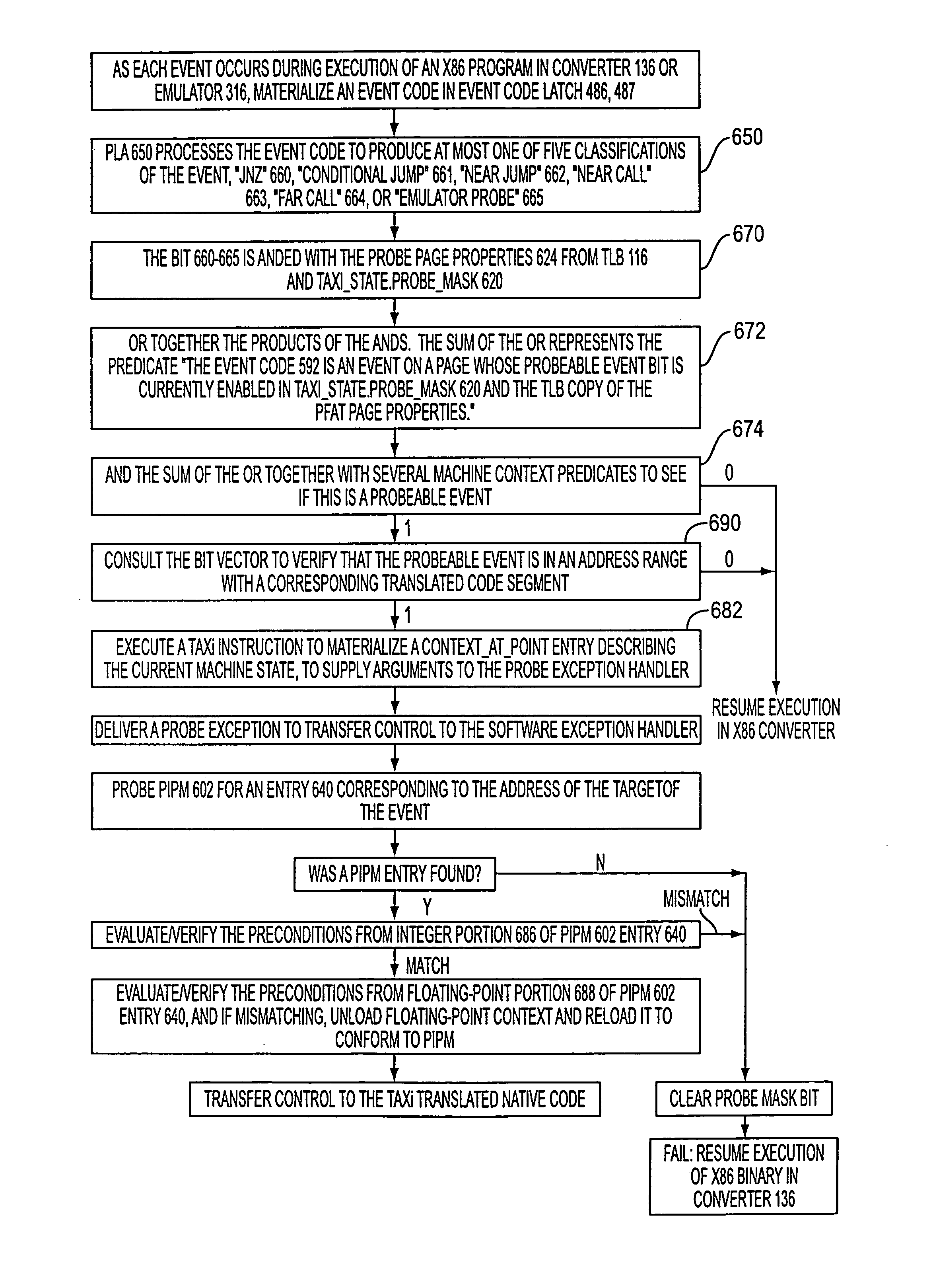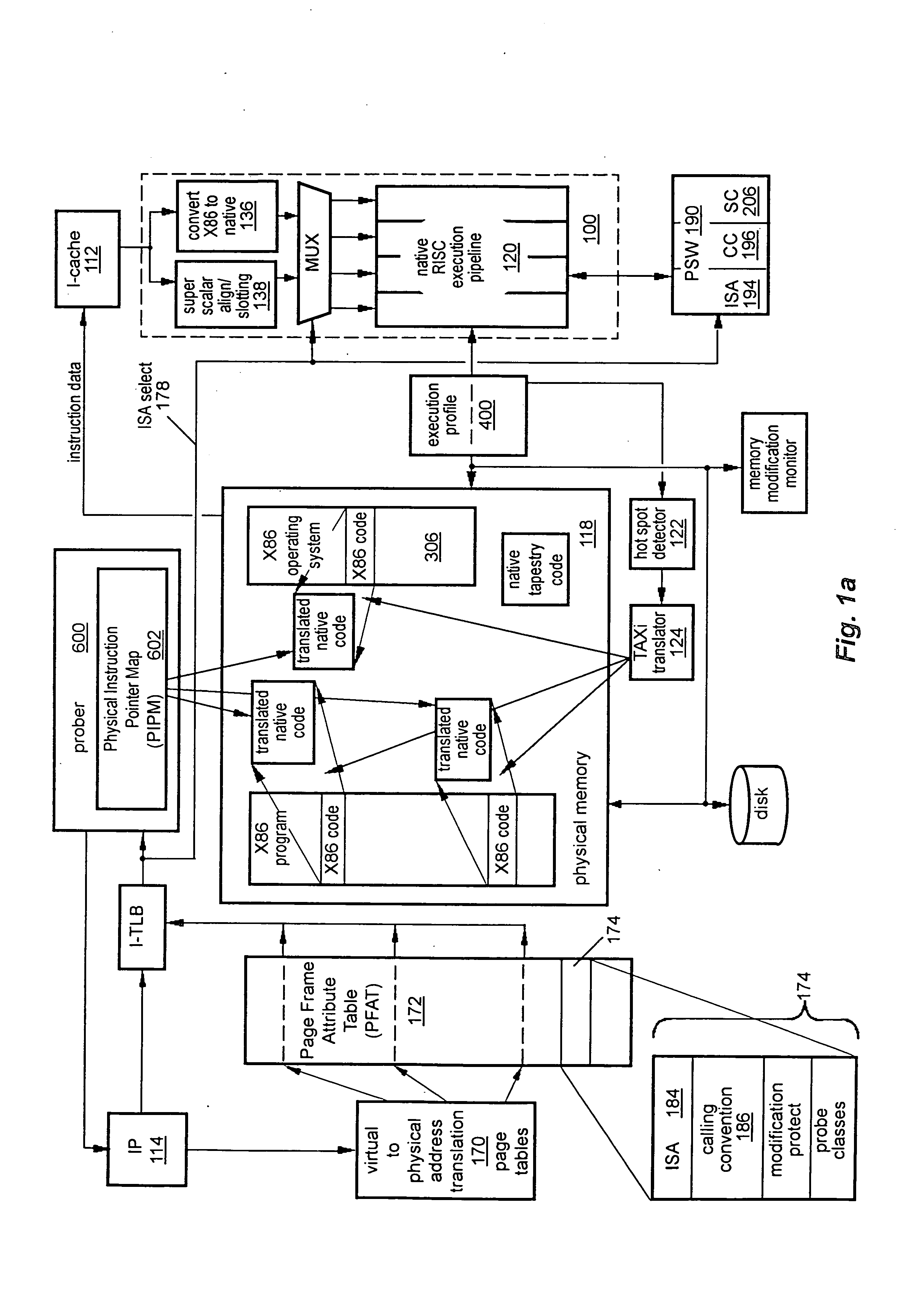[0032] Embodiments of the invention may include one or more of the following features. The profiled execution interval is commenced at the expiration of a
timer, the recorded profile describing a sequence of events including every event that matches time-independent selection criteria of events to be profiled, the recording continuing until a predetermined stop condition is reached. A profile entry is recorded for later analysis noting the source and destination of a
control flow event in which
control flow of the program execution diverges from sequential execution. The recorded profile information is efficiently tailored to identify all bytes of
object code executed during the profiled execution interval, without reference to the binary code of the program. A profile entry describing a single profileable event explicitly describes a page offset of the location of the event, and inherits a page number of the location of the event from the immediately preceding profile entry. Profile information records a sequence of events of the program, the sequence including every event during the profiled execution interval that matches time-independent criteria of profileable events to be profiled. The recorded profile information indicates ranges of instruction binary text executed by the computer during a profiled interval of the execution, the ranges of executed text being recorded as low and high boundaries of the respective ranges. The recorded high boundaries
record the last
byte, or the first
byte of the last instruction, of the range. The captured profile information comprises subunits of two kinds, a first
subunit kind describing an instruction interpretation mode at an instruction boundary, and a second
subunit kind describing a transition between processor
modes. During a non-profiled interval of the program execution, no profile information is recorded in response to the occurrence of profileable events matching predefined selection criteria for profileable events. The profile circuitry is designed to
record a
timestamp describing a time of the recorded events. The profile circuitry is designed to
record an event code describing the class of each profileable event recorded. A number of bits used to record the event code is less than log2 of the number of distinguished event classes.
[0038] In general, in a twenty-fourth aspect, the invention features a computer. The
instruction pipeline is configured to execute instructions of the computer. The profile circuitry is implemented in the
computer hardware, and is configured to detect, without
compiler assistance for execution profiling, the occurrence of profileable events occurring in the
instruction pipeline, and to direct recording of profile information describing the profileable events occurring during an execution interval of the program. Profile control bits implemented in the
computer hardware have values that control a resolution of the operation of the profile circuitry. A binary translator is configured to translate programs coded in a first
instruction set architecture into instructions of a second
instruction set architecture. A profile analyzer is configured to analyze the recorded profile information, and to set the profile control bits to values to improve the operation of the binary translator.
[0080] Embodiments of the invention may offer one or more of the following advantages.
[0081] A program produced for a computer of an old architecture can be executed on a computer of a new architecture. The old binary can be executed without any modification. Old binaries can be mixed with new—for instance, a program coded for an old architecture can call
library routines coded in the new instruction set, or vice-versa. Old libraries and new libraries may be freely mixed. New and old binaries may share the same
address space, which improves the ability of new and old binaries to share common data. Alternatively, an old binary can be run in a protected separate
address space on a new computer, without sharing any data with any new binary. A caller need not be aware of the ISA in which the callee is coded, avoiding the burden of explicitly saving and restoring context. The invention reduces
software complexity:
software need not make explicit provision for all possible entries and exits from all possible
modes and mixtures of binaries. The pipelines for
processing old instructions and new instructions can share pieces of the implementation, reducing the cost of supporting two instruction sets. A new computer can fully model an older computer, with no reliance on any
software convention that may be imposed by any particular software product, allowing the new computer to run any program for the old computer, including varying off-the-shelf operating systems. Because translated target code is tracked in association with the physical pages of the
source code, even if the physical pages are mapped at different points in the virtual address spaces, a single translation will be reused for all processes. This is particularly advantageous in the case of shared libraries.
[0082] The profile data may be used in a “hot spot”
detector, that identifies portions of the program as frequently executed. Those frequently-executed portions can then be altered, either by a
programmer or by software, to run more quickly. The profile data may be used by a binary translator to resolve ambiguities in the binary coding of instructions. The information generated by the profiler is complete enough that the hot spot
detector can be driven off the profile, with no need to refer to the instruction text itself. This reduces
cache pollution. Ambiguities in the X86 instruction text (the meaning of a given set of instructions that cannot be inferred from the instruction text, for instance the
operand size information from the segment descriptors) are resolved by reference to the profile information. The information collected by the profiler compactly represents the information needed by the hot spot
detector and the binary translator, with relatively little overhead, thereby reducing
cache pollution. The profiler is integrated into the hardware implementation of the computer, allowing it to run fast, with little
delay on a program—the overhead of profiling is only a few percent of execution speed.
 Login to View More
Login to View More  Login to View More
Login to View More 


